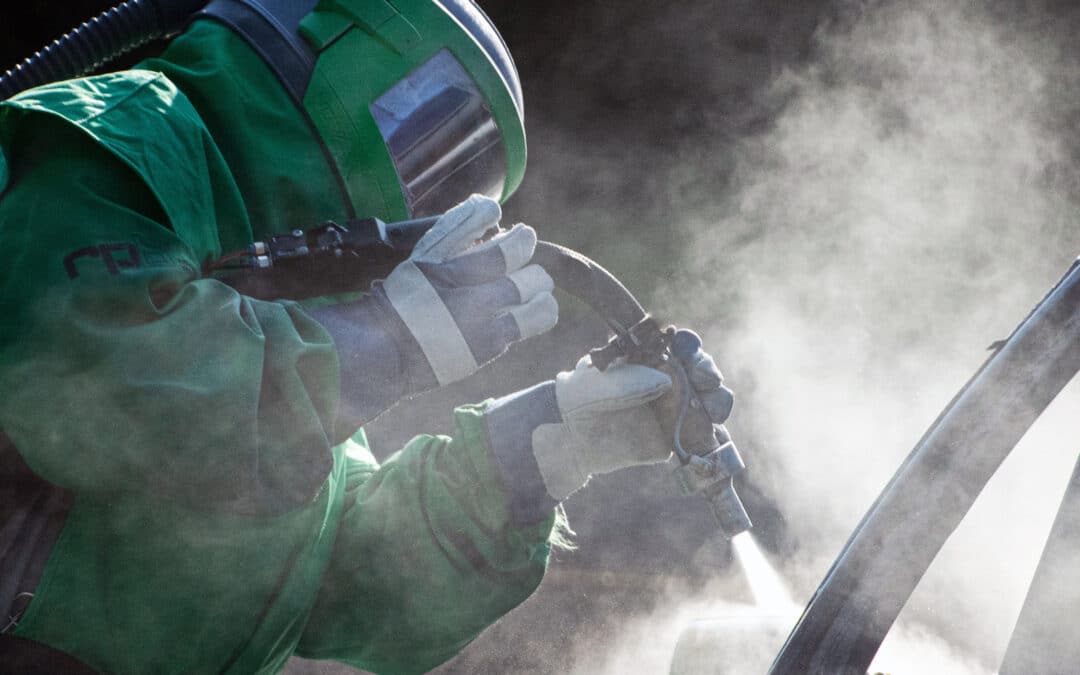It’s called wet abrasive blasting, vapor blasting, and even dustless blasting. But what is this process, and is it right for your surface preparation project?
Wet abrasive blasting is a time-tested method of removing coatings, residues, contaminants, and corrosion from a variety of surfaces. It is similar to traditional dry sand blasting except that it uses water to moisten the abrasive material.
It is a misnomer to call this process “dustless” since no form of surface blasting is entirely dust free. However, a significant advantage of wet abrasive blasting is that it produces much less dust than traditional dry blasting methods. Some studies indicate that wet abrasive blasting creates as much as 92 percent less dust than dry sand blasting.
The reduction of dust means operators are exposed to fewer contaminants, and wet blasting requires less time and money spent on containment. Wet abrasive blasting also creates a clean, consistent finish with less embedded particles that is in many cases ready to coat after a good rinse cycle.
How does wet abrasive blasting work?
Wet abrasive blasting combines high-pressure water, compressed air, and abrasive material such as recycled crushed glass. This liquid abrasive mixture is sent to one or more nozzles where the operator can then use a regulator to adjust the pressure as the mixture blasts the surface to achieve the desired finish.
One way to look at wet abrasive blasting is as a combination of traditional dry blasting and pressure washing. The water works as a lubricant and creates a barrier between the abrasive material and the surface and helps cut down significantly on airborne dust particles.
The water basically traps the majority of dust particles, preventing them from escaping into the air.
What are some ways to use wet abrasive blasting?
Wet abrasive blasting can work as a surface cleaner, degreaser, or de-scaler for just about any material, including the following applications:
- Concrete surface cleaning
- Aluminum, stainless steel, and other metal cleanings
- Rust, Mill Scale, and Corrosion removal
- Wood stripping and restoration
- Powder coating and paint removal
- Automotive and heavy equipment cleaning
- Swimming pool calcium removal
- Graffiti removal
- Plastic surface cleaning
- Stone and brickwork cleaning
- Historical renovations
Since wet blasters operate effectively at a lower PSI (pounds per square inch), the method works well on fragile and soft surfaces – even antiques.
What are the advantages of wet abrasive blasting?
Here is an overview of the advantages of wet abrasive blasting:
- Safety. Although it does not eliminate dust, wet blasting reduces more than 90 percent of dust over dry blasting. Not only can dust become explosive – especially when mixed with metals — it can be dangerous for workers to breathe dust. Airborne particles can cause lung and vision damage and other long-term health issues.
- Better for the environment. Wet abrasive blasting allows fewer chemicals and particles to enter the air. When working outdoors, the work area is easier to set up and clean up. This process is much different than power washing – the water used while blasting is typically less than 10 Gallons Per Hour. Power Washing consumption rates get measured in Gallons Per Minute.
- Less warping. In materials where warping is a concern, wet blasting is a great option. The water acts as a barrier, reducing the heat and friction that causes warping.
- Custom finishes. Wet abrasive blasting offers many finish choices. Use of various medias and pressure combinations can attain different profiles and surface cleanliness levels.
- Compliance. The process is here to stay – AAMP (formerly known as SSPC) now publishes formal Wet Abrasive Blasting (WAB) specifications for firms to follow for critical coating projects.
Also, since the media used in wet abrasive blasting is encased in water, it does not ignite sparks as easily when compared to dry blasting, making it a safer option in many instances.
Should you use wet abrasive blasting for your surface cleaning project?
With wet abrasive blasting, you can achieve your surface cleaning goals quickly and efficiently, saving money on set up and clean up, minimizing downtime, and helping to keep workers and the environment safer.


